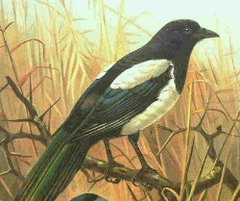European Magpie
|
|
| European Magpie | ||||||||||||||
|---|---|---|---|---|---|---|---|---|---|---|---|---|---|---|
 European Magpie | ||||||||||||||
| Scientific classification | ||||||||||||||
| ||||||||||||||
| Binomial name | ||||||||||||||
| Pica pica (Linnaeus, 1758) |
The European Magpie (Pica pica) is a resident breeding bird throughout Europe, much of Asia, and northwest Africa.
There are numerous races. Recent research has indicated that the Korean race, P. pica sericea, is genetically very distinct from the other Eurasian forms, and may be a separate species. The northwest African race P. p. mauretanica and the southwest Arabian race P. p. asirensis are also distinct in plumage and may also be separate species. The North American Black-billed Magpie is almost identical to the Eurasian form, and was previously considered conspecific, but was found to be genetically closer to the Yellow-billed Magpie.
The strikingly pied plumage and long (20-30cm), graduated tail, as well as its loud, harsh chatter, prevent confusion with any other species. In the open country the Magpie commands attention as one, two, three or more birds, with rapidly moving, apparently short wings, fly in succession, chattering as they pass. When the bird alights the long tail is at once elevated and is carefully carried clear of the ground.
The European Magpie is 40-51cm in length. Its head, neck and breast are glossy black with a metallic green and violet sheen; the belly and scapulars are pure white; the wings are black glossed with green or purple, and the primaries have white inner webs, conspicuous when the wing is open. The graduated tail is black, shot with bronze-green and other iridescent colours. The legs and bill are black.
The young resemble the adults, but are at first without much of the gloss on the sooty plumage. The male is slightly larger than the female.
The northwest African race differs in having a patch of bare skin around the eye and no white patch on the rump, and the southwest Arabian race differs in being smaller, with dull black plumage lacking iridescent tones, and minimal white in the wings. The east Asian races have more extensive white in the wings.
Like other corvids, such as crows, the Magpie's usual gait is a walk, but when attracted by food or any special object it hops quickly sideways with wings just open. The fondness of all its family for bright objects is well known.
No animal food comes amiss to the Magpie; young birds and eggs, small mammals and insects are devoured, but acorns, grain and other vegetable substances are not despised. The fact that the magpie basically eats anything has given name to the pica psychical disorder, where the victim tends to eat things that the body cannot digest.
Tall trees are selected by the Magpie for its bulky nest; it is firmly attached to a central fork in the upper branches. The framework of the sticks is cemented with earth and clay. and a lining of the same material is covered with fine roots; above is a stout, though loosely, built dome of prickly branches with one well-concealed entrance. When the leaves fall these huge nests are plainly visible. Where trees are scarce, and even in well-wooded country, nests are at times built in bushes and hedgerows.
The eggs, small for the size of the bird, number from five to eight, and as many as ten are recorded; they show much variation in ground and marking, but a usual type is blue-green with close specks and spots of brown and grey. They are laid in April, and only one brood is reared unless disaster overtakes the first clutch.
In country areas the bird, owing to persecution, is often shy, but in suburban areas it is common. Indeed, where it is not molested it courts rather than avoids the vicinity of man. Also, it is known to team up in bands of two or more to "tease" cats, i.e. launch feigned attacks on the animals, perhaps as a general reaction against the cat as predator and egg thief.
In winter the Magpie becomes gregarious, wandering and feeding in small parties or flocks, and gathering at a common rendezvous to roost at night. Early in the year large numbers collect together for mating. Charles Darwin refers to these congregations as "marriage meetings".
In the nuptial display, the males rapidly raise and depress their crests, uplift, open and close their tails like fans, and call in soft tones quite distinct from their usual chatter. In the display the loose feathers of the flanks are brought over and the primaries, and the patch on the shoulders is spread so as to make the white conspicuous, presumably to attract the female eye. Short buoyant flights and chases are part of the courtship.
Folklore
Magpie_hopscotch.jpg
A traditional English rhyme records the traditional belief that seeing a certain number of magpies was a prediction of your future.
The rhyme runs:
- One for sorrow
- Two for mirth
- Three for a wedding
- Four for a birth
- Five for rich
- Six for poor
- Seven for a witch
- I can tell you no more.
Alternate versions of this counting rhyme include:
- One for sorrow,
- Two for joy,
- Three for a girl,
- And four for a boy,
- Five for silver,
- Six for gold,
- Seven for a secret never to be told.
- One for sorrow
- Two for mirth
- Three for a death
- Four for a birth
- Five for heaven
- Six for hell
- Seven's the Devil his own sel'
According to Terry Pratchett:
There are many rhymes about magpies, but none of them are very reliable, because they are not the ones the magpies know.
-from Carpe Jugulum
"The Magpies" is also a nickname for the English football club Newcastle United, owing to their black and white strip.bg:Сврака da:Husskade de:Elster es:Urraca fr:Pie (oiseau) lt:Šarka nl:Ekster pl:Sroka zh:喜鹊 ja:カササギ sv:Skata
